BISAC NAT010000 Ecology
BISAC NAT045050 Ecosystems & Habitats / Coastal Regions & Shorelines
BISAC NAT025000 Ecosystems & Habitats / Oceans & Seas
BISAC NAT045030 Ecosystems & Habitats / Polar Regions
BISAC SCI081000 Earth Sciences / Hydrology
BISAC SCI092000 Global Warming & Climate Change
BISAC SCI020000 Life Sciences / Ecology
BISAC SCI039000 Life Sciences / Marine Biology
BISAC SOC053000 Regional Studies
BISAC TEC060000 Marine & Naval
It is known that considerable part of living matter in the ocean falls out of biological cycle irretrievably by way of sedimentation. It means that quasi-stationary state of oceanic ecosystems is possible only with supply of mineral and organic matter from land. That supply, which includes also contaminating matter, takes place mainly in near-shore regions, concentrates in bottom boundary layers, and is transferred to the open sea via shelves by means of horizontal and vertical mixing. Effective mixing in shelves is carried out by small-scale processes, which are considerably fed by energy of large-scale processes from out-of-shelf regions. The main objective of our paper is to identify mechanisms of energy transfer from large to small-scale motions and from open sea to near-shore areas. Our experiments and observations in the shelf zone of the Sea of Japan revealed important specific features in stratified bottom boundary layers: 1) Temporal intermittence of internal waves (IW) in near-bottom layers and their transformation into sequences of stratified boluses moving in non-stratified medium. 2) Extremely high horizontal and vertical velocities in the near-bottom layers. 3) Considerable power fluctuations caused by correlated fluctuations of near-bottom pressure and velocity. 4) Non-monotonic vertical structure of temperature and velocity leading to possibility of simultaneous existing of IW breaking and secondary generation of high-frequency IW by turbulence in layers with high curvature of velocity profiles. Taking into account satellite observations of high correlation between chlorophyll-a concentration in coastal and in out-of-shelf waters, as well as dispersion relations for different types of internal waves and results of our field experiments we suggest that interconnection of biological parameters in coastal and in open sea waters is exercised substantially by gravitational and inertial internal waves generated by tides and eddies in the region of continental slope near the shelf boundary.
open sea, shelf, near-shore region, boundary layer, eddies, tides, internal waves, mixing
I. Introduction
Continental shelves are extremely important for humanity from many points of view. They are the site of the most effective interaction between land and ocean, as well as between human and ocean. Providing maximum ratio of food production to expenditures they are at the same time extremely saturated by contaminants of anthropogenic origin, leading to biochemical, thermal and noise pollution. Dynamic sea-shore interactions also give their considerable positive and negative inputs. Maximum sedimentation together with maximum resuspension and remineralization have important consequences for bottom morphology and for biological, acoustical and optical properties of shelf waters.
Looking at the ocean as a limited (though unclosed) physical object, it is necessary to study internal processes and effects of processes at its boundaries, which by their nature are, to a designated degree, fuzzy. In the deep ocean the main attention is justly given to the surface, that is to the surface boundary layer, where exchange processes with external medium are going on. In the coastal ocean, on the contrary, the most important and changeable are processes at the lower boundary, namely, in the bottom boundary layer. As for horizontal boundaries, we have two regions: near the shelf break (over the continental slope) and near the shores (with depths less than 30-
II. Processes near the shelf break and phytoplankton distribution
The main energy containing processes in the adjacent to the continental slope region are currents, tides and mesoscale eddies, which have tendency to move along the shelf break. By virtue of many satellite and field observations it was found out that the main effects on phytoplankton horizontal and vertical distribution are performed by mesoscale eddies [1, 2, 3]. Satellite pictures of a part of the Sea of Japan including Peter the
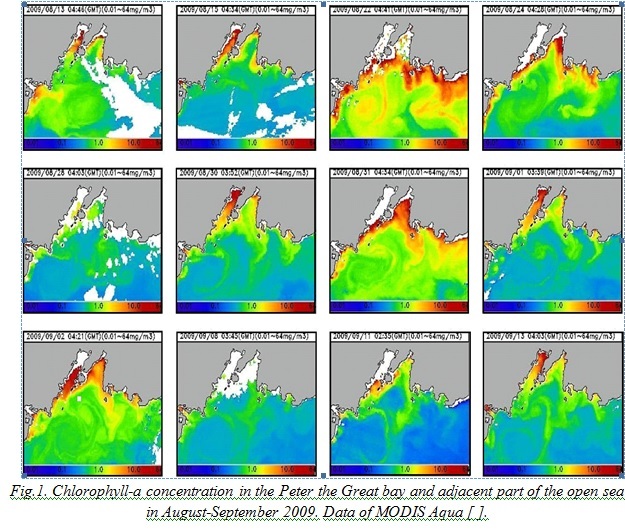
III. Processes in bottom boundary layers and their relation to large-scale motions
It is frequently supposed that high productivity in shelf zones is due to wind driven mixing penetration deep enough to intersect with the bottom boundary layers. In such cases waters are saturated by necessary elements from bottom as well as from air. Though wholly mixed layers do not always give maximum productivity, such assertion can be true only in not frequent periods of very strong winds. In most cases there exist bottom boundary layers practically not sensitive to processes in upper mixed layers. Our experiments, conducted in the shelf zone of the Peter the Great bay, have shown that intense motions and corresponding mixing can exist in calm sea conditions. Strong currents with high horizontal and vertical gradients of velocity, needed to produce considerable turbulent mixing, are not typical for near-shore regions, and tidal currents and their vertical gradients are also small in the region. So, the question is: where from is energy for mixing in near-bottom layers?
The answer is rather evident from Fig.1, where temporal fluctuations of temperature are shown, registered with the help of 20-30 probes with 0.5 m vertical separation along each of 3 strings. Internal waves with amplitudes of 10-15 m, having trapped cold cores inside them, are propagating past the string located at the point with 30 m bottom depth. At the points with bottom depth of 20 and 15 m we see the cold boluses, separated by homogeneous warm water. It is very important that IW, having huge kinetic and potential energy, do not break within the time of their periods, but carry their energy through the homogeneous medium nearer to shores. The spans of time when IW and boluses can reach regions with the smallest depths can be the periods of maximum phytoplankton bloom and chlorophyll concentration.
.jpg)
Fig.2. Internal waves and boluses measured at three strings located in three points with different depths.
The most regular and generally recognized mechanism of IW generation is interaction of barotropic tide with continental slope near the shelf break. In Fig.3 an example of numeric calculations is given using our model described in [4]. Tidal fluctuations for that run were specified as integral flow, corresponding to harmonic fluctuations of velocity with the amplitude 20 cm/s . Density was set constant from surface till the depth 20 m, than augmenting linearly till
.jpg)
After the moments of reverse from rising to low tide (t=30h in our case) the IW phase velocity sharply decreases and their steepness increases (the picture at t=33h). In that phase nonlinear effects become maximum, and in the time span between 33h and 36h very steep high amplitude frontal waves generate packets of shorter waves, which have lesser velocities and must fall behind the longer waves. Long tails of waves with decreasing amplitudes are formed in the beginning of the next rising tide (see the moments 36h and 38h).
Majority of our observations were rather well correlated with surface tides, but in Fig.1 the period about 17 h prevails, which is close to the local inertial period f. It means that in Fig.1 we deal with inertia-gravitational IW, which have inertial frequency f as the lower boundary for their existence. Paths of particles in pure inertial waves with frequency close to f (the upper boundary for them) are ellipses in horizontal plane, so that in the region over the continental slope inertial waves can generate considerable vertical movements with periods close to 1/f in the same way as barotropic tides.
To estimate quantitatively the role of bottom boundary layers the long-run measurements of different parameters were performed. In Fig.4 is shown spectrum of pressure fluctuations, measured close to bottom at the depth of 20 m during 42 days in August-September 2008. Besides distinct extreme values at tidal periods near 25 and 12 h (semidiurnal mixed tide is typical in the region), we see the peaks, corresponding to long-term fluctuations with the periods 2 and 8 days, which can be caused by synoptic processes in sea and atmosphere. The well pronounced peaks are in the range of internal gravitational waves and possible seiches, and there is rather weak energy attenuation in the range of prevailing IW periods from 6 hours till 10 minutes.
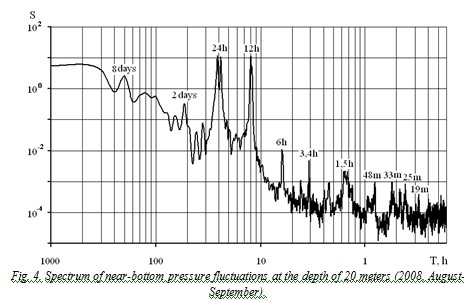
In Fig.5 are shown fluctuations of pressure and temperature near the bottom measured with the help of SBE26. Temperature fluctuations are produced by tidal IW and in general they follow the pressure fluctuations, but they have much higher amplitudes in short-period range and their periodicity is not so strong as in tides. Intervals between characteristic phases can be in the range 9-15 h for semidiurnal tides. The shifts from the 12 h period are due to fluctuations of internal tide phase velocity, depending on the Brunt-Vaisala fluctuations on the way from the shelf break to the point of measurements.
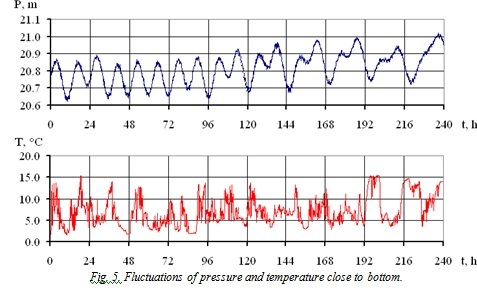
Fig. 5. Fluctuations of pressure and temperature close to bottom.
Interconnection between pressure and temperature fluctuations can be presented in more detail with the help of their spectra, shown in Fig. 6 in logarithmic scale. The all distinctive peaks coincide in the spectra, and the cross-spectrum STP clearly confirms that the main inputs in temperature fluctuations are due to internal tides. At the same time we see considerable fluctuations of temperature in high-frequency range, which are not distinctly reflected in pressure. The part of spectrum SP corresponding to periods less than 30-20 min is like the white noise. As for the general slope -2 in the temperature spectrum, it is rather frequent in our spectral analysis of many temperature series, though not more frequent than the slope -3.
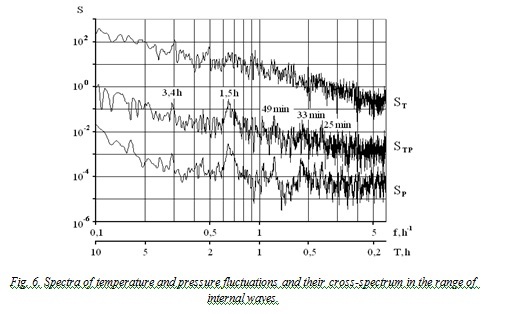
Actually the problem is in the fact, that the spectral slope can reflect the character of energy fluxes between different spectral components, which can point to self-similarity of dynamic processes. So long as prevailing dynamic processes can change with depth, we can obtain different spectra at rather close levels. That is especially interesting and important for bottom boundary layers known for their complicated vertical structure. An example of such complications is given in Fig.7.
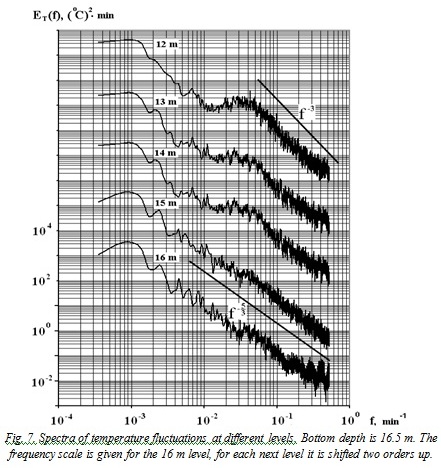
The most important feature of temperature fluctuations that can be seen in Fig. 7 is change of their spectral structure with depth inside the near-bottom layer from the exponential low f -3 at the upper level to f -5/3 at the lower level (
The slope -3 for internal waves in shelf zones was obtained in the result of many measurements analyzed in [5] and some other papers, but here we have rather different picture. The spectral form similar to spectra at levels 12, 13 and
The transition of energy from internal waves in upper parts of the near-bottom thermocline into horizontal turbulence in its lower parts seems natural from the physical point of view. In highly nonlinear and breaking near-bottom internal waves the upper water particles overrun the lower ones. That leads, as a consequence of continuity, to high upward vertical velocities inside the wave body and to compensating horizontal velocities in its lower layers. In that way quasi-horizontal turbulence must be generated in close to bottom layers in addition to small-scale three-dimensional turbulence, characteristic for bottom friction layers.
The vertical structure of momentum fluxes can be represented by products of horizontal and vertical components of velocity. In Fig.8 we can see that during the 35 days in calm sea conditions, when wind-driven mixing was limited by the depth of about 4 m, horizontal momentum fluxes were the same order as in the upper mixed layer, and vertical momentum fluxes were in many cases greater than in the upper mixed layer. Taking into account, that horizontal velocity in the bottom layer generally was less than in the upper layer, we can conclude that processes in the bottom layer can be more three-dimensional than in the upper layer.
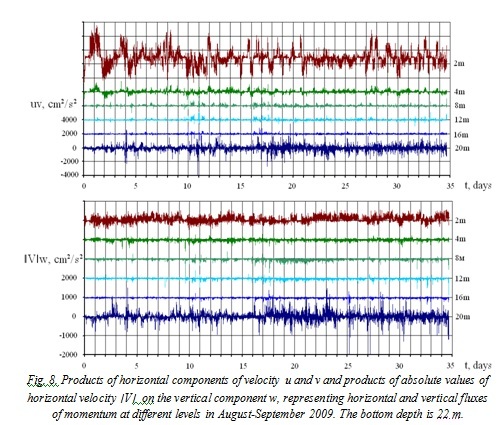
Fig. 8. Products of horizontal components of velocity u and v and products of absolute values of horizontal velocity ׀V׀ on the vertical component w, representing horizontal and vertical fluxes of momentum at different levels in August-September 2009. The bottom depth is
IV. Conclusions
It is generally acknowledged that high biological productivity in the continental slope regions is due to upwelling of nutrient reach waters from the depths with elevated sedimentation. But it is evident that such waters contain only small part of the total export of terrestrial matter from shelves to oceans. And the main parts of shelves, accumulating and providing the matter, are near-shore shallow regions. There is very small kinetic energy in these regions in comparison to the open ocean, and none the less there must be intense mixing to include sediments into exchange with remote waters. The most energy containing motions are in deep regions. We have shown that energy of large scale motions can reach near-shore regions via internal waves and that general tendency is as follows: energy from the ocean to shores, matter from shores to the ocean. Of course, that is not strict rule. If internal waves can bring cold water to shores (and that is necessary for ventilation of shallow waters and sustaining ecology), they can bring back to shores the waste products thrown down somewhat farther into sea just into the bottom boundary layer. But that important part of the problem was out of scope of the present paper.
V. Acknowledgment
The work was supported by the Russian Foundation for Basic Research, Grant No. 15-05-03805. The author is thankful to E.Pavlova for help in execution of figures.
1. Y.S. José, O. Aumont, E. Machu, P. Penven, C.L. Moloney, and O. Maury, "Influence of mesoscale eddies on biological production in the Mozambique Channel: Several contrasted examples from a coupled ocean-biogeochemistry model", Deep-Sea Research II, vol.100, pp. 79-93, 2014.
2. T.Lamont, R.G.Barlow, T.Morris, M.A.vandenBerg, " Characterisation of mesoscale features and phytoplankton variability in the Mozambique Channel", Deep-Sea Research II, vol. 100, pp. 94-105, 2014.
3. J.-P. Gattuso, M. Frankignoull, and R. Wollast, "Carbon and carbonate metabolism in coastal aquatic ecosystems", Annu. Rev. Ecol. Syst., vol. 29, pp. 405-34, 1998.
4. V.V. Navrotsky, V.L. Izergin, E.P. Pavlova, “Generation of internal waves near the shelf boundary”, Transactions of Russian Academy of Sciences, Doklady Earth Sciences, vol. 388, no. 1, pp.84-88, 2003.
5. V.V. Navrotsky, J.D. Lozovatsky, E.P. Pavlova, H.J.S. Fernando, “Observations of internal waves and thermocline splitting near a shelf break of the Sea of Japan (East Sea)”, Continental Shelf Research, vol. 24, pp.1375-1395, 2004.
6. H. Van Haren, “Internal wave-turbulence pressure above sloping sea bottoms”, Journal of Geophysical Research, vol. 116, C12004, 2011.







